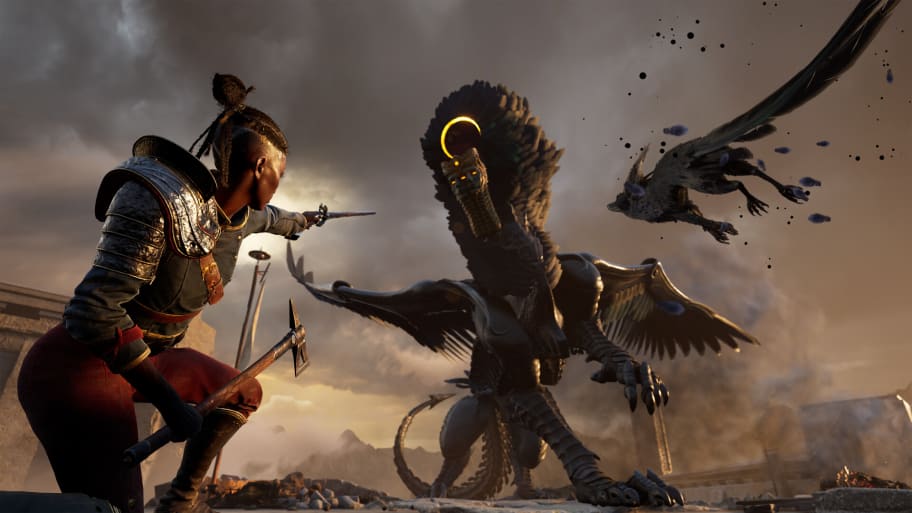Nothing turns me off of a game quicker than when I can feel it going down the checklist of standard features publishers think every game needs to hold players’ attention, and Flintlock: The Siege of Dawn ticks so many of these boring boxes.
There’s an immortal non-human companion that yaps on endlessly about every bit of scenery that enters their field of vision. Crafting resources you must gather for gear upgrades. A special ability tied to the aforementioned companion that should serve as a unique selling point for the combat, but instead feels tacked on after the fact. A smattering of side-quests with uninteresting stories, and a skill tree full of incremental upgrades and abilities, most of which don’t make a noticeable difference to gameplay.

While I could just type the word “generic” into thesaurus.com, copy/paste the results, and call it a review, there are things Flintlock does worth talking about where it steps outside of its comfort zone – though it doesn’t do all of them well.
First is the platforming. To give you a bit of variety from the samey-looking terrain you trudge around, you get fairly powerful double-jump and air-dash abilities to leap around the scenery with. Plus there are certain places where you can activate rifts that let you fly across entire areas, which you can then combo into platforming abilities.
This feels really nice when it works, but most of the time it’s frustrating. As you’d expect, a big part of this moveset is you automatically grabbing ledges to end your jumps, but the problem is it’s a complete coin flip whether she’ll actually do it or not. There was more than one occasion where I thought I was going the wrong way because no matter what I did she wouldn’t grab a ledge, only for it to suddenly work on the eighth time I tried it. Some of these were even ledges that had very clear chalk markings indicating this is a grabbable ledge.
On top of that, no attempt is made to put any of this fun movement into the combat. It’s used occasionally as an excuse to give you a more acrobatic dodge animation, but nothing that sets it apart from other soulslike combat systems. I was hoping that these skills were added to give fights more wide-scale action with verticality and speed, especially as Flintlock’s marketing explicitly promises this, but they never blossomed into anything special.

Flintlock has the fundamentals of this kind of combat system down. I could point to plenty of games that do it better, but its strikes feel weighty and impactful, enemies’ movements can be read clearly, and the basic block, parry, and dodge mechanics are all as responsive as you’d expect.
There are attempts to add layers to the combat, but most of them just end up making it more frustrating. Armor and shields are the big ones in this category. Armor makes enemy health bars more resilient to your aimless wailing, and instead, you need to use your companion – a fox-like god named Enki – to curse them, after which striking them will fill the curse bar until you can destroy the armor. What I found is that this doesn’t make fights more challenging, it just makes them longer, and it’s even more tedious when shields make them almost entirely immune to damage from the front.
What does work is the firearm system. By landing melee attacks you charge up uses of your black powder, which allows you to fire your pistol. Doing this while an enemy is winding up an unblockable attack will do big damage, interrupt the attack, and give you an opening to strike further. You also have a secondary firearm which is much slower and has limited uses, but does bigger damage and has enough range to end fights before they even begin.

This helps with the push-your-luck style of gaining currency. As you’d expect from a soulslike, you get currency from defeating enemies and drop it all when you die. It’s a classic risk/reward system that keeps every fight tense, but Flintlock also uses it on a smaller scale. As you defeat enemies and use a variety of abilities in combat you build up a multiplier.
At any time you can manually cash in this multiplier, adding much more earned cash to your total, but it’s all lost when you take any damage. It’s a wonderful way to bait you into risk-taking behavior and healthily rewards those skilled enough to defeat tough bosses or hordes of enemies without taking a hit.
Enki has more uses outside of helping you defeat armor, but they don’t feel properly integrated into the gameplay. You can unlock abilities that damage enemies, hold them in place, or add status effects, but none of them are powerful enough to be the center point of a build. Instead, it feels like a side feature that doesn’t impact any other part of the combat system, so it was always my last consideration when putting together my gear and deciding on my tactics.

Even as a character, Enki is only good as an embodiment of how uninteresting Flintlock’s world and story are. Once upon a time, a world with a mix of Victorian-era weaponry and magic would’ve been intriguing, but we’ve seen that enough times that I need something more to keep me interested, and this game doesn’t have it. Instead, we have some gods to defeat who are all vaguely evil in different ways that ultimately blend into one.
Flintlock: The Siege of Dawn simply isn’t memorable in any way. It has perfectly fine combat, but it’s filled with little frustrations that bury the few innovations that work. Movement outside of combat is often unreliable and satisfying, and it’s all backed up by a story that failed to grab me at every turn. There are glimpses of good ideas, but none of them ever get fleshed out.
Score: 5/10
Version tested: PC (Steam)
More must-reads:
- Five worst signings from the first day of NHL free agency
- Two notable ex-Lakers figures could join Mavericks
- The 'NBA all-time assists leaders' quiz
Breaking News
Trending News
Customize Your Newsletter
 +
+
Get the latest news and rumors, customized to your favorite sports and teams. Emailed daily. Always free!








